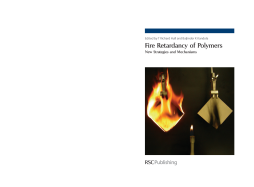
BOOK
Fire Retardancy of Polymers
Nicolas Cinausero | Bob Howell | Gerd Schmaucks | Gyorgi Marosi | Zbigniew Brzozwski | J-M Lopez Cuesta | Gordon Nelson | Giovanni Camino | Charles Wilkie | Alberto Fina | Jianwei Hao | Shonali Nazare | Everson Kandore | John Staggs | Y C Wang | Sophie Duquesne | Robert Hicklin | Phil Wakelyn | Sabyasachi Gaan | A R Horrocks | Paul Joseph | David Purser | Anna Stec | Mohamed Hassan | Cheryl Kindness | B B Marosfoi | T Richard Hull | Baljinder K Kandola
(2008)
Additional Information
Book Details
Abstract
Globally, fire retardants are needed to satisfy a multibillion dollar market. Fire retardancy of polymeric materials is an important component of fire safety. Fire retardants either reduce the likelihood of ignition and/or reduce the rate of flame spread and hence, escalation of fire. The need to comply with safety legislations forces industry to use fire retardants in materials in order to save lives. With growing consumer demands and new legislations, the development of new systems is an on-going process, which also involves understanding their mechanisms of action. This book covers the latest developments in fire retardant strategies including: " new fire retardant systems (including nanoparticulate fillers, sometimes combined with conventional fire retardants) " intumescent formulations and their recent applications in bulk polymers, fibres and textiles " test-methods for material flammability " material-specific aspects of combustion, smoke and toxicity. Fire retardant strategies covered, include the use of synergistic combinations of alumina with organoclay, organophosphorus compunds, silica and organosilicones, clay-phosphate combinations and a novel tecnhique for investigating fire rerardant behaviour. The section on nanoparticulate fillers includes an investigation on the effect of filler shape, the use of carbon nanofibres and nanotubes, the interpretation of nanocomposite behaviour in the cone calorimeter, and groundbreaking new research on the influence of rheological properties on burning behaviour. The coverage of fibres and textiles includes a discussion on trends in textile fire retardancy and flammability regulations, and some novel halogen-free approaches to fire retardancy of cellulose, acrylic and polypropylene textiles. Finally, the influence of fire retardants on fire toxicity is discussed in detail, followed by an investigation of the toxic products from burning fire retarded polymer nanocomposites. This book will update fire retardant materials' developers with latest in research and design of new fire retardant materials. It will also provide a snapshot of the state-of-the-art for a range of other groups including environmentalists looking for alternatives to brominated flame retardants and engineers needing to use fire safe materials in their projects.
T Richard Hull is Professor of Chemistry and Fire Science at the University of Central Lancashire. His research focuses on fire retardancy and toxicity and he was involved in the development of the first ISO standard for assessment of fire gas toxicity. He has collaborated extensively with the main fire retardant groups across the globe. A recurrent theme in his work is the use of instrumental methods to understand fire behaviour. Baljinder K Kandola is Professor of Materials Fire Science at the University of Bolton, UK. Her career started with a PhD in chemistry and she has since worked on a range of multidisciplinary research projects involving chemistry, textiles, mechanical engineering and mathematics. Her interests are focused on fire retardancy of natural fibres, thermoplastic fibre-forming polymers and thermoset polymers. Her recent research includes burning and burning induced degradation of mechanical properties of fibre reinforced composites.
